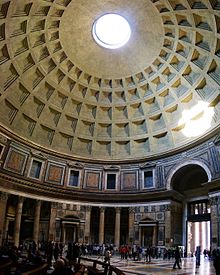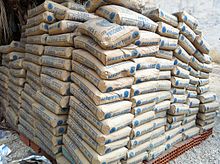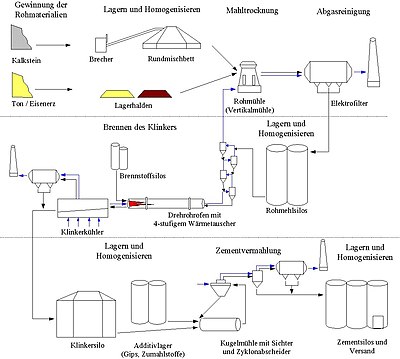Cement
![]()
This article explains the building material cement; for other, derived meanings, see Cement (disambiguation).
![]()
This article or section is still missing the following important information:
A redirect cement plaster leads to this article. However, the term is then not explained at all; in particular, there is no explanation of what distinguishes "cement plaster" from other types of plaster.
Help Wikipedia by researching and adding them.
Cement (Latin caementum "quarry stone", "building stone") is an inorganic and non-metallic building material. It is finely ground and therefore counts as a bulk material. Due to its properties, it is produced as a building material in cement works and used to make building components and structures. Within building materials, cement is a binder. It hardens through chemical reaction with water (hydration) and then remains solid. For the production of building materials such as mortar and concrete, so-called addition water (formerly "mixing water") and other substances are added to the cement powder as aggregates. Due to the worldwide availability of raw materials, as well as the strength and durability of concrete, cement is one of the most important binders worldwide. With a global production of 4.1 billion tons in 2017, cement is the most widely used material of all.
Cement is produced in cement plants. For its production, the natural raw materials limestone and clay are used, which are often present as a natural mixture and are then referred to as marl. If necessary, quartz sand and substances containing iron oxide are also added as corrective materials for better sintering. The raw materials are ground into raw meal and then heated to about 1,450 °C until they partially fuse with each other at the grain boundaries (sintering) and the so-called cement clinker is formed. The now spherical material is cooled and ground into the final product, cement. In order to obtain cement types with specific properties, granulated blastfurnace slag, fly ash, limestone and gypsum can be added in different dosages and finenesses before grinding.
The impact of cement production on the environment has so far been considered problematic. The cement industry is one of the main producers of greenhouse gases that cause global warming. Based on global annual production, the release of carbon dioxide bound in lime results in emissions of at least three billion tons of CO2, or about 6 to 8 % of annual CO2 emissions, which is three to four times the magnitude of all air traffic.

Cement has been used as a building material since ancient times: the cement dome of the Pantheon in Rome, completed during the time of Emperor Hadrian between 125 A.D. and 128 A.D., was the largest dome in the world for more than 1700 years.

A pile of sand (brown) and cement (grey) prepared for mixing.

Bagged cement in Tunisia
History
The German word Zement goes back to the Latin term opus caementitium. The opus caementitium, which was already known to the Romans more than 2000 years ago, was not cement in the modern sense, but a concrete-like masonry. It can be regarded as the precursor of today's concrete and consisted of burnt limestone as a binder and stones, sand and pozzolans as aggregates. As the opus caementitium was resistant to water, it was used for the construction of water pipes and harbour piers, but also for foundations and for buildings such as the Colosseum and the Pantheon.
Later, cementum, cimentum, cäment and cement were used to describe aggregates such as volcanic ash, pozzolana and brick dust, which were added to burnt lime to obtain a hydraulic binder (hydraulic lime, water lime). The importance of the clay content for the hydraulic properties of cement (roman cement) was discovered by the Englishman John Smeaton (1724-1792). Since then, cement no longer stands for the aggregate, but the binder.
The Frenchman Louis-Joseph Vicat (1786-1861) laid the foundations for the development of cement and lime mortar with the rediscovery of "Roman cement" and the invention of artificial hydraulic lime.
The Englishman Joseph Aspdin (1778-1855) is considered to be the actual inventor of Portland cement. In 1824 he was granted the patent An Improvement in the Mode of Producing an Artificial Stone; in the patent specification he used the term "Portland cement". The name was based on Portland stone, a limestone that was quarried on the Portland peninsula on the English Channel coast and was similar in colour to the artificial products made from Portland cement.
This "Portland cement" was not yet cement in the modern sense, but artificial Roman cement: Isaac Charles Johnson (1811-1911) was apparently the first to recognize the importance of sintering in 1844 and, with his improved process, introduced the "real", overburned Portland cement into the building trade, where it quickly displaced Roman cement due to its superior hardness.
In 1838, the first German cement plant was founded in Ulm by the Ulm pharmacist Gustav Ernst Leube and his brothers. The first German Portland cement based on the English model was produced in Uetersen. The foundation for the production of Portland cement in Germany was laid by Hermann Bleibtreu (1821-1881), who also built two cement plants in Züllchow near Stettin (1855) and in Oberkassel near Bonn. Wilhelm Michaëlis (1840-1911) had a decisive influence on further developments. In his book entitled Die hydraulischen Mörtel (Hydraulic Mortars), published in 1868, he was the first to provide precise information on the most favourable composition of the raw material mixture. One of the oldest existing buildings constructed using Portland cement is the Alte Schmiede (Old Forge) at Spittastrasse 40 in Berlin-Lichtenberg, which was built by Berliner Cement AG from 1871 onwards.
In 1877, all 23 existing German Portland cement manufacturers joined together to form the Verein Deutscher Portland-Cement-Fabrikanten (German Portland Cement Manufacturers' Association) in order to "clarify all technical and scientific questions of importance to the cement industry in joint work". In 1878, together with the German Association for the Manufacture of Bricks, Pottery, Lime and Cement (Deutscher Verein für Fabrikation von Ziegeln, Tonwaren, Kalk- und Zement), which in 1876 started to work out a uniform testing procedure and to draw up regulations for the demands to be made on the quality of cement, and in conjunction with the architects' associations, the Berlin building market and the brick industry, the first Prussian standards for the testing of Portland cement were issued, which were immediately prescribed for all state buildings.
Manufacturing Process
The raw material for cement is ground and mixed from mainly natural raw materials in a dry process, then burned, cooled and ground again in a continuous process in rotary kilns. Typical throughputs of the rotary kilns are 3,000 to 10,000 tonnes of clinker per day.
The predecessors of the dry process for grinding raw materials were wet and semi-wet processes, in which the raw materials were ground and mixed in the wet state. However, due to the high energy input during subsequent drying, these processes are generally no longer competitive today.
The raw materials are limestone (calcium carbonate as a source of calcium oxide), clay (for silica and alumina), sand (for silica) and iron ore (iron(III) oxide). Cements with different chemical and physical properties can be produced by adding additives such as granulated blast furnace slag, pozzolan or fly ash. Gypsum or anhydrite is added to the final product.
The raw materials are mined in quarries or opencast mines, pre-crushed in crushers and transported to the cement plant. In a vertical mill or raw mill, all raw materials are ground together and dried at the same time. The resulting raw meal is then burned in a rotary kiln at temperatures of approx. 1,400-1,450 °C to produce so-called cement clinker. During burning, the carbon dioxide bound in the lime is released. After cooling to a temperature of below 200 °C, the grey-brown granules are then ground together with gypsum in a ball mill to produce the finished product, cement.
See also: Technical lime circuit#Burning the lime.

Schematic of a cement plant.
Search within the encyclopedia